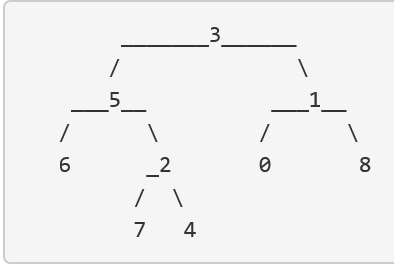https://leetcode.com/problems/lowest-common-ancestor-of-a-binary-tree/
Given a binary tree, find the lowest common ancestor (LCA) of two given nodes in the tree.
According to the definition of LCA on Wikipedia: “The lowest common ancestor is defined between two nodes v and w as the lowest node in T that has both v and w as descendants (where we allow a node to be a descendant of itself).”

For example, the lowest common ancestor (LCA) of nodes 5 and 1 is 3. Another example is LCA of nodes 5 and 4 is 5, since a node can be a descendant of itself according to the LCA definition.

/** * Definition for a binary tree node. * struct TreeNode { * int val; * TreeNode *left; * TreeNode *right; * TreeNode(int x) : val(x), left(NULL), right(NULL) {} * }; */ class Solution { public: void findPath(TreeNode* root, vector<TreeNode* >& load, vector<TreeNode* >& path, TreeNode* p) { if(root == NULL) return; if(root == p) { path = load; return; } load.push_back(root->left); findPath(root->left, load, path, p); load.pop_back(); load.push_back(root->right); findPath(root->right, load, path, p); load.pop_back(); } void reverse_vector(vector<TreeNode* > v) { vector<TreeNode* > res; res.clear(); for(int i=v.size()-1;i>=0;--i) res.push_back(v[i]); v = res; } TreeNode* lowestCommonAncestor(TreeNode* root, TreeNode* p, TreeNode* q) { if(p == q) return p; vector<TreeNode* > load1, load2, path1, path2; TreeNode *r = root; load1.push_back(r); load2.push_back(r); findPath(r, load1, path1, p); findPath(r, load2, path2, q); reverse_vector(path1); reverse_vector(path2); int i = 0, j = 0, m = path1.size(), n = path2.size(), resi; cout << m << n << endl; while(i < m && j < n && path1[i] == path2[j]) { resi = i; ++i; ++j; } return path1[resi]; } };
